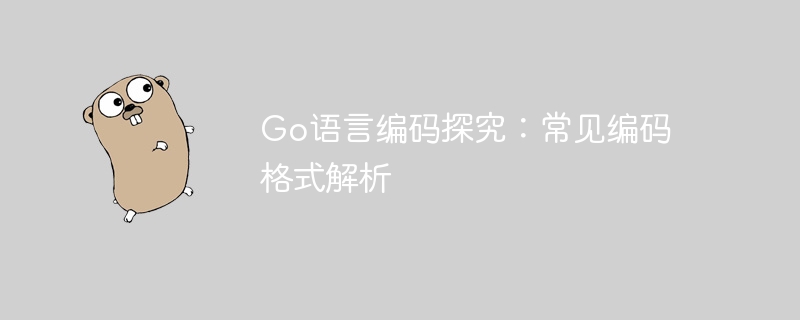Home >Backend Development >Golang >Go language coding exploration: analysis of common coding formats
Go language coding exploration: analysis of common coding formats
- WBOYWBOYWBOYWBOYWBOYWBOYWBOYWBOYWBOYWBOYWBOYWBOYWBOriginal
- 2024-03-29 09:48:031322browse

Go language coding exploration: analysis of common encoding formats
In software development, data encoding is a crucial concept. Different encoding formats have different impacts on data storage, transmission, and processing, and appropriate encoding formats can improve data efficiency and reliability. In the Go language, there are also many common encoding formats. This article will explore several common encoding formats and provide specific code examples.
JSON
JSON (JavaScript Object Notation) is a lightweight data exchange format that is easy to read and write. In the Go language, we can use the encoding/json package to implement JSON encoding and decoding operations. The following is a simple example:
package main
import (
"encoding/json"
"fmt"
)
type Person struct {
Name string `json:"name"`
Age int `json:"age"`
Email string `json:"email"`
}
func main() {
person := Person{
Name: "Alice",
Age: 30,
Email: "alice@example.com",
}
// 将结构体编码为JSON字符串
jsonData, err := json.Marshal(person)
if err != nil {
fmt.Println("JSON encoding error:", err)
return
}
fmt.Println(string(jsonData))
// 将JSON字符串解码为结构体
var decodedPerson Person
err = json.Unmarshal(jsonData, &decodedPerson)
if err != nil {
fmt.Println("JSON decoding error:", err)
return
}
fmt.Println(decodedPerson.Name, decodedPerson.Age, decodedPerson.Email)
}XML
XML (Extensible Markup Language) is a markup language commonly used for data storage and exchange. In the Go language, we can use the encoding/xml package to process XML data. The following is a simple example:
package main
import (
"encoding/xml"
"fmt"
)
type Person struct {
Name string `xml:"name"`
Age int `xml:"age"`
Email string `xml:"email"`
}
func main() {
person := Person{
Name: "Bob",
Age: 25,
Email: "bob@example.com",
}
// 将结构体编码为XML字符串
xmlData, err := xml.Marshal(person)
if err != nil {
fmt.Println("XML encoding error:", err)
return
}
fmt.Println(string(xmlData))
// 将XML字符串解码为结构体
var decodedPerson Person
err = xml.Unmarshal(xmlData, &decodedPerson)
if err != nil {
fmt.Println("XML decoding error:", err)
return
}
fmt.Println(decodedPerson.Name, decodedPerson.Age)
}Protocol Buffers
Protocol Buffers is a An efficient data exchange format that can be used for serialization and deserialization of structured data. In the Go language, we can use the github.com/golang/protobuf library to implement the encoding and decoding operations of Protocol Buffers. The following is a simple example:
package main
import (
"log"
"github.com/golang/protobuf/proto"
)
type Person struct {
Name string
Age int
Email string
}
func main() {
person := &Person{
Name: "Charlie",
Age: 35,
Email: "charlie@example.com",
}
// 将结构体编码为Protocol Buffers数据
data, err := proto.Marshal(person)
if err != nil {
log.Fatal("protobuf encoding error:", err)
}
// 将Protocol Buffers数据解码为结构体
var decodedPerson Person
err = proto.Unmarshal(data, &decodedPerson)
if err != nil {
log.Fatal("protobuf decoding error:", err)
}
log.Println(decodedPerson.Name, decodedPerson.Age, decodedPerson.Email)
}The above is about the Go language A brief introduction and code examples of common encoding formats JSON, XML and Protocol Buffers. By learning and practicing these coding formats, we can help us better process data and improve the efficiency and reliability of our programs.
The above is the detailed content of Go language coding exploration: analysis of common coding formats. For more information, please follow other related articles on the PHP Chinese website!

